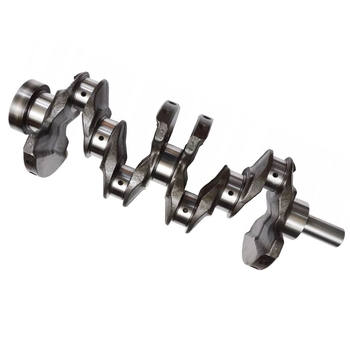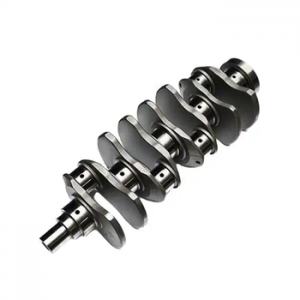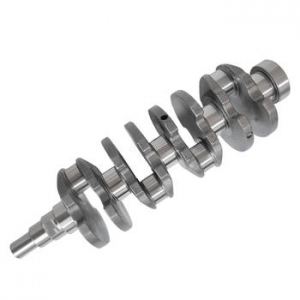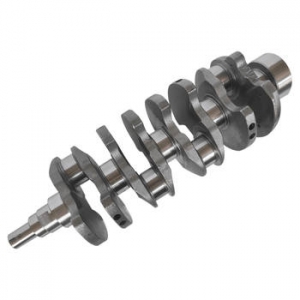When it comes to the heart of an internal combustion engine, few components bear as much stress and responsibility as the crankshaft. This vital part converts the linear motion of the pistons into rotational motion, powering everything from cars and trucks to heavy machinery and marine vessels. Given the immense forces at play – rotational, bending, torsional, and shear stresses – the material properties and manufacturing precision are absolutely critical. This is where forged crankshafts distinguish themselves. Unlike cast crankshafts, which are formed by pouring molten metal into a mold, forged crankshafts are shaped under immense pressure from a solid billet of steel or alloy. This forging process aligns the grain structure of the metal along the length of the crank, significantly enhancing its strength, durability, and fatigue resistance. Think of it like working dough – kneading and shaping it creates a stronger, more consistent texture than simply letting it set. Forging achieves a similar effect on metal at a molecular level. The reliability demanded by modern engines, especially those operating under extreme conditions or designed for high performance, makes the forged crankshaft the material of choice. Consequently, selecting the right **Forged Crankshaft Manufacturers** is a decision that directly impacts the lifespan, efficiency, and performance of the entire engine system. The expertise required to consistently produce crankshafts that meet stringent dimensional tolerances, material specifications, and surface finish requirements is substantial, setting apart the leaders in this specialized field from the rest.
The Art and Science of Forging Crankshafts
Understanding the forging process is key to appreciating the quality difference offered by expert **Forged Crankshaft Manufacturers**. The process typically begins with selecting high-quality steel alloys, often containing elements like chromium, molybdenum, or vanadium to enhance strength and toughness. This billet is heated to a specific forging temperature, where it becomes malleable but remains solid. It is then subjected to intense pressure, usually through drop forging or press forging methods, using dies that shape the metal into the rough form of a crankshaft. This mechanical working of the metal refines the grain structure, eliminates internal voids or porosity that can occur in casting, and increases the density and overall strength. It's frankly a brutal but incredibly effective process. After the initial forging, the crankshaft goes through various subsequent stages including trimming of excess material (flash), and often thermal treatments like normalizing or tempering to achieve the desired hardness and reduce internal stresses. The accuracy of the dies and the control over temperature and pressure throughout the forging cycle are paramount. Any deviation can lead to defects that compromise the structural integrity of the finished product. This is why partnering with manufacturers who have deep experience and sophisticated equipment is non-negotiable for applications where reliability is paramount. Interestingly enough, while the basic principle of forging is ancient, its application to complex geometries like crankshafts, demanding micro-level material control, is a modern marvel of engineering and metallurgy.
Precision Machining: Honing the Forged Form
While forging provides the necessary strength and structural integrity, it's only the first step. The forged blank is still a rough shape and requires extensive precision machining to become a functional crankshaft. This stage involves turning, milling, grinding, and drilling operations to shape the main bearing journals, rod bearing journals, crank pins, counterweights, flanges, and other critical features to incredibly tight tolerances. Modern **Forged Crankshaft Manufacturers** rely heavily on advanced Computer Numerical Control (CNC) machining centers for these processes. CNC technology allows for highly repeatable, precise cuts and shapes, ensuring that each crankshaft meets the exact specifications of the design. The alignment, diameter, and surface finish of the bearing journals are particularly critical, as they determine how smoothly the crankshaft rotates within the engine block and how well the bearings function. Any inaccuracies here can lead to excessive wear, vibration, and premature failure. Furthermore, balancing is a crucial machining step. Counterweights are shaped and sometimes material is removed to ensure the crankshaft rotates with minimal vibration at high speeds. This process is often performed on dynamic balancing machines. The combination of the strength provided by forging and the accuracy achieved through state-of-the-art machining is what makes forged crankshafts the preferred choice for demanding engine applications. To be honest, without this level of precision, even the strongest forging would be useless in a high-performance engine.
Quality Control and Material Science Expertise
The best **Forged Crankshaft Manufacturers** don't just forge and machine; they back their processes with rigorous quality control and deep metallurgical expertise. Quality begins with the selection of the raw material. Verifying the chemical composition and mechanical properties of incoming steel billets is the first critical check. Throughout the forging and machining process, various inspection methods are employed. These include dimensional inspections using coordinate measuring machines (CMMs) to verify geometric accuracy, surface finish measurements using profilometers, and non-destructive testing (NDT) methods to check for internal flaws or surface cracks. Common NDT techniques include magnetic particle inspection, ultrasonic testing, and dye penetrant inspection. Furthermore, material properties are verified through destructive testing of sample parts or test coupons, including tensile strength tests, hardness tests, and fatigue testing. Understanding how different heat treatments affect the microstructure and mechanical properties of the steel is also vital. For example, induction hardening is often used to selectively harden the bearing journal surfaces, providing wear resistance while maintaining toughness in the core of the crankshaft. A manufacturer's ability to control these complex material science aspects is a hallmark of their expertise. It’s worth noting that these comprehensive checks aren't just about meeting a standard; they are about ensuring that a component operating under incredible stress will not fail prematurely, potentially causing catastrophic engine damage. Many experts agree that a manufacturer's investment in quality control infrastructure and personnel is a direct indicator of the reliability of their products.
Applications Demanding Forged Strength
The inherent strength and durability of forged crankshafts make them indispensable across a wide range of industries where engine reliability and performance are critical. In the automotive sector, they are standard in high-performance engines, sports cars, and heavy-duty trucks designed for towing or commercial transport. Racing engines, which experience extreme RPMs and loads, almost exclusively use forged crankshafts. This leads us to the need for **custom forged crankshafts for racing engines**, where specific stroke lengths, journal diameters, and counterweight designs are required to optimize performance for particular engine configurations and racing disciplines. Beyond road vehicles, forged crankshafts are essential in marine engines, powering everything from leisure boats to large commercial ships, where reliability in harsh environments is non-negotiable. They are also vital in industrial power generation equipment, compressors, pumps, and construction machinery – applications where engines run continuously under heavy loads for extended periods. Furthermore, the aerospace industry uses forged components, including crankshafts for piston aircraft engines, where safety and reliability are paramount. Frankly speaking, any application where an engine's failure could lead to significant downtime, safety risks, or economic losses benefits greatly from the superior properties of a forged crankshaft. This widespread demand highlights the critical role played by capable forged crankshaft suppliers in various global industries.
Choosing the Right Forged Crankshaft Supplier
Selecting the appropriate **Forged Crankshaft Manufacturers** is a strategic decision for any business relying on high-performance or heavy-duty engines. It's not just about the price; it's about reliability, consistency, and technical partnership. What should you look for? Firstly, assess their experience and track record. How long have they been producing forged crankshafts? Can they demonstrate successful projects in applications similar to yours? Ask about their production capacity and lead times – consistency in delivery is as important as product quality, especially for manufacturers with tight production schedules. Evaluate their quality control procedures and certifications (e.g., ISO 9001, IATF 16949 for automotive). Do they have in-house testing facilities, including NDT and material analysis? Consider their technical capabilities – can they work with various steel alloys? Do they have expertise in specific forging methods or heat treatments required for your application? Can they handle complex geometries and tight tolerances, including supplying **forged crankshaft suppliers for heavy-duty applications** with specific size and strength requirements? A manufacturer who can offer design assistance or provide insights based on their experience can be an invaluable partner. Have you ever wondered about the true cost of a cheap component failure? Often, it far outweighs any initial savings. Partnering with a manufacturer known for quality is an investment in reliability and performance.
Innovation and Future Trends
The field of forged crankshaft manufacturing isn't static; it's continuously evolving through innovation in materials, processes, and inspection technologies. Material scientists are exploring new high-strength alloys that offer improved fatigue life or allow for lighter designs without sacrificing strength. Advancements in forging simulation software allow manufacturers to optimize the forging process, predicting material flow and potential defects before ever hitting the shop floor, reducing waste and improving quality. Precision machining continues to improve, with multi-axis CNC machines capable of machining complex crankshaft geometries in fewer setups, increasing efficiency and accuracy. Robotic automation is increasingly being integrated into manufacturing lines for material handling, machining, and inspection, leading to greater consistency and throughput. Furthermore, non-destructive testing techniques are becoming more sophisticated, allowing for faster and more detailed internal inspection of parts. Surface treatments, such as nitriding or specialized coatings, are also being refined to further enhance wear resistance and fatigue strength on critical surfaces. These ongoing developments mean that **Forged Crankshaft Manufacturers** who invest in research and development and adopt new technologies are better positioned to meet the increasingly demanding requirements of modern engines and industrial applications. Remaining competitive in this space requires a forward-looking approach and a commitment to continuous improvement.
Partnering for Performance and Reliability
Ultimately, the performance and reliability of any engine are intrinsically linked to the quality of its core components, none more so than the crankshaft. Forging offers a superior foundation for this critical part, providing the strength and resilience needed to withstand immense operational stresses. Choosing from the pool of **Forged Crankshaft Manufacturers** requires careful consideration of their expertise, technological capabilities, quality control processes, and ability to consistently deliver parts that meet exact specifications. A reputable manufacturer not only provides a high-quality product but also acts as a reliable partner in your supply chain, contributing to your own production efficiency and the end-product's reputation for durability. We understand the challenges involved in sourcing critical engine components and the absolute necessity for unwavering quality. Our company has built its reputation on delivering forged crankshafts that meet the highest industry standards, leveraging advanced forging techniques, precision machining, and stringent quality assurance protocols. We work with a variety of materials and can produce crankshafts for diverse applications, from automotive to heavy industrial machinery, offering solutions that address the specific needs of your projects. Ensuring every part meets dimensional accuracy and material property requirements is at the core of our operation, providing the reliability your applications demand.
For more detailed information, please visit our official website: Forged Crankshaft Manufacturers





